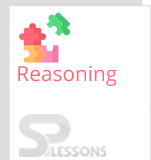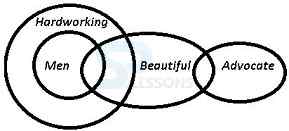 Introduction
Introduction
What is a Syllogism?
A syllogism is a deductive argument relating two premises and a conclusion, all of which are quantified propositions, i.e. propositions joining concepts by using words such as ‘some’ and ‘all’. In simple terms, Syllogism is a deductive argument that is primarily composed of 3 propositions. One of the propositions is used as the conclusion of the syllogism and the other two propositions are used as the premises of the syllogism. Deductive Logic is used to derive conclusions from premises where the truth of the conclusion must always be contained in the truth of the premises. Syllogism Practice Quiz 5 presents Syllogism questions with solutions useful for candidates preparing for different competitive examinations like RRB ALP/Technical Exams/Junior Engineer Recruitment Exams, SSC CGL,SSC CHSL, IBPS, SBI PO, SBI Clerks, CAT and etc.
Syllogism is derived from the Greek word syllogismos, meaning conclusion or inference. Some syllogisms contain three components:
- Major Premise
- Minor Premise
- Conclusion
 Quiz
Quiz
1. Statements:
Some wildlife are reserve.
All lands are forest.
Some reserve are not forest.
Conclusions:
I. All land can never be reserve.
II. Some reserve are forest.
- A. Only I follows
B. Both I and II follow
C. Only II follows
D. None follows
- A. Only I follows
B. Both I and II follow
C. Only II follows
D. Either I or II follows
- A. Only II follows
B. Both I and II follow
C. Only I follows
D. Either I or II follows
E. None of these
- A. Only I follows
B. None follows
C. Both I and II follow
D. Only II follows
- A. Only II follows
B. Both I and II follow
C. None follows
D. Either I or II follows
Directions(1-2): In each of the questions below are given some statements followed by some conclusions. You have to take the given statements to be true even if they seem to be at variance from commonly known facts. Read all the conclusions and then decide which of the given conclusions logically follows from the given statements disregarding commonly known facts.
1. Statements:
Some sky are banana.
All bananas are drop.
Some drops are limit.
Conclusions:
I. All limit can never be sky.
II. Some drops are sky.
III. No limit is sky.
- A. Only I follows
B. Only II follows
C. Only I and II follow
D. Only III follows
- A. Only I follows
B. Only II and III follow
C. Only I and either II or III follow
D. Only I and II follow
- A. Only I follows
B. Only II follows
C. Only III follows
D. Only II and III follow
- A. (a) Only I follows
B. Only II and III follows
C. Only III follows
D. Only III and I follow
- A. Only I and II follow
B. Only II follows
C. Only II and either I or III follow
D. All follow
Direction(1-3): In each of the following questions below are given some statements followed by some conclusions. Taking the given statements to be true even if they seem to be at variance from commonly known facts, read all the conclusions and then decide which of the given conclusion logically follows the given statements.
1. Statements:
No cups are plate
All plates are spoons
Conclusions:
I. Some cups are spoons.
II. Some spoons are plates.
III. Some plates are spoons.
- A. Only conclusion (II) follows
B. Only conclusion (III) follows
C. Only conclusion (I) and (III) follow
D. Only conclusion (II) and (III) follow
- A. Only conclusion (III) follow
B. Only conclusion (I) and (III) follow
C. Only conclusion (II) and (III) follow
D. Only conclusion (I) and (II) follow
- A. Only conclusion (II) follows
B. Only conclusion (IV) follows
C. Only conclusion (I) follows
D. No conclusion follows
- A. None follows
B. Only either I or III follows
C. Only II and III follow
D. Only III and IV follow
- A. Only conclusion I follows
B. Only conclusion II follows
C. Either I or II follows
D. Neither I nor II follows














